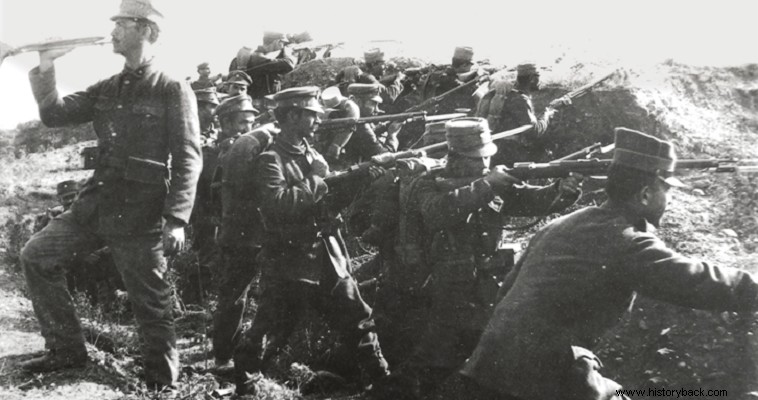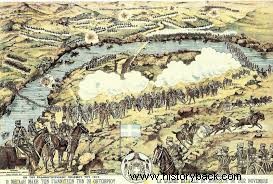
After its victory in Sarandaporos, the Greek Army continued its movement to the North. On October 19, the Greek forces moved on both sides of the lake of Giannitsa. The I, II, III, IV and VI Infantry Divisions (MP) marched north and the VII MP, Konstantinopoulos' Evzone Detachment (AE) and the Cavalry Brigade (TI) marched south. The Greek headquarters considered the possibility of Turkish forces in the area unlikely. But the Turks denied it.
The opposing forces
Turkish forces were deployed defensively north of the lake in a desperate attempt to cover the main routes to Thessaloniki. The defense of the location was undertaken by the 14th Turkish Division of Serres, with three infantry regiments, the Catherine Detachment (four battalions), one cavalry regiment, five artillery divisions and auxiliary forces.
Remnants of the 22nd Infantry Division and the Neapolitan Division, which had been assembled after the retreat from Sarantaporos, had also been deployed. A total of 25,000 Turks had taken up positions in the gorge between Mount Paikos and Lake Giannitsa.
Against these forces the Greek army enjoyed a clear numerical superiority. It had six strong infantry divisions and the Cavalry Brigade and the euzon detachments. But without having the slightest information about the position of the enemy, the Greek army got involved in the battle under unfavorable conditions. On the northern side of the lake, where four Greek divisions were squeezed in, the limited width of the strait between Mount Paikos and the lake did not allow them any possibility of maneuver.
All they could do was to attack on a 10 km wide front the prepared positions of the Turks, who, fortified on the surrounding heights, had excellent observation and extensive firing ranges. The location could be broken, of course, by an attack from the sector south of the lake which did not provide the same advantages to the defender.
The battle begins
As they marched, the Greek forces received enemy fire. The battle of Giannitsa has begun. The Turks had established outposts some distance from their main defensive line. The line of their vanguard, however, was overturned by the I/12th Battalion of the III MP, which pursued the Turks acrobats to such an extent as to capture the Aspropotamos river bridge intact, almost in front of the main enemy position. Divisions of the III and II MP tried to exploit the success of the battalion. But they failed in front of the heavy fire of 30 Turkish guns.
Thus the I/12th Battalion remained only on the eastern bank of the river. The commander-in-chief was only informed about the events at noon and immediately issued an order, according to which the 4th MP had to attack the village of Pentaplatanos, a northern support point of the Turkish line, in order to support the action of the II and III MP against Giannitsa . Also the VII MP was ordered to speed up its movement south of the lake so as to be south of the Turkish position. In the meantime the battle on the banks of Aspropotamos had intensified.
The artillery of the Greek divisions had in turn entered the battle, forcing the corresponding Turkish, if not to become silent, at least to greatly limit its action. With the support of the artillery, the II and the larger part of the III MP crossed the river, from the bridge of Melissi. However, although the divisions crossed the river, they did not seek to make contact with the enemy and limited themselves to taking security measures. Only the IV MP attacked with all three of its regiments and by the afternoon had managed to capture part of the enemy's main defensive line.
The Turks for their part, taking advantage of the inactivity of the other two Greek divisions, did not hesitate to launch a fierce counterattack against the exposed right flank of the IV Division (8th Infantry Regiment). The Greek soldiers, however, stubbornly put up a heroic defense and crushed the Turkish counterattack. The III/8th Infantry Battalion, in particular, fought admirably and repulsed the Turks at the critical moment.
A little later the heroic IV MP linked up with the VI, which in the meantime had advanced and after a hard fight had penetrated the enemy location as well. The 9th Evzones Battalion, under Lt. Col. Dionysios Papadopoulos, managed with a heroic raid to break through the enemy location as far as the artillery positions.
Overnight on the battlefield
Soon night fell and the Greek divisions spent the night in the positions they had occupied, very close to the enemy trenches, ready to settle their differences with the Turks at first light the next day. The night was rainy and cold. From their positions the men listened to the cries of anguish of the wounded lost in the darkness. Soaked to the bone, fasting and starving, the Greek soldiers stoically endured the hardships, in the vision of a great homeland.
Unfortunately the next day's fighting would be just as tough as the VII MP had not received the commander-in-chief's order to move quickly to the south of the Turkish position. So all that remained was a continuation of the frontal attack on Giannitsa. At first light on October 20, the fight was repeated with unprecedented ferocity.
In the sector of the VI MP, the heroic 9th Battalion of Evzones, rushed with the lance against the defenders in the cemetery of Pentaplatanos. With the flag in front and the trumpet to mean "advance, advance", the euzones "took a phalanx", as they said, the Turks. Sweeping away all resistance, the euzones overpowered even a Turkish artillery supporting the defenders in the cemetery.
At the same time, the other Greek divisions rushed out. IV literally broke up the Turks and forced them to retreat. The II MP was also advanced and forced the opposite Turks to retreat. The III MP, due to the marshy ground, advanced more slowly. But the battle had already been decided after the division of the enemy location by the VI and IV MPs.
The Turkish commander, realizing the futility of continuing the fight as well as the risk of cutting off his forces, ordered their retreat east of Axios. The retreating movement of the Turks was not hindered by the overworked Greek divisions. After all, the intact I MP, which was ordered to pursue the enemy, got mixed up with the transports of the other divisions and lost valuable time. However, the Greek victory was an indisputable fact and its price, if one considers the intensity of the fight, relatively low.
The losses of II, III and VI MP amounted to 188 dead and 785 wounded. There is no information about the losses of the IV MP, which must have been serious. Turkish losses were also unaccounted for. However, in the worst case they must have been similar to the Greek ones. On October 20, a battle also broke out south of the Giannitsa lake, between units of the VII MP and Turkish units in Platy. The Greek divisions finally prevailed and pursued the Turks east of the Loudia River.

The Turks are defending the bridge at Platy, being fired upon by the Greek artillery.

Popular lithograph of the era depicting the battle of Giannitsa.

The Greek sections outside the city of Giannitsa.
